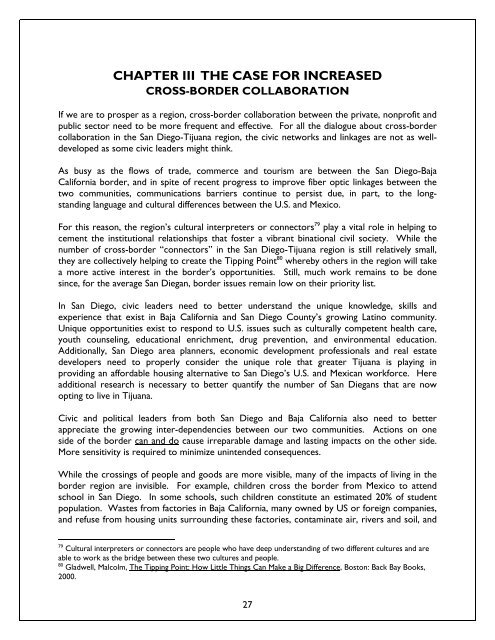Blurred Borders - International Community Foundation
Blurred Borders - International Community Foundation
Blurred Borders - International Community Foundation
You also want an ePaper? Increase the reach of your titles
YUMPU automatically turns print PDFs into web optimized ePapers that Google loves.
CHAPTER III THE CASE FOR INCREASED<br />
CROSS-BORDER COLLABORATION<br />
If we are to prosper as a region, cross-border collaboration between the private, nonprofit and<br />
public sector need to be more frequent and effective. For all the dialogue about cross-border<br />
collaboration in the San Diego-Tijuana region, the civic networks and linkages are not as welldeveloped<br />
as some civic leaders might think.<br />
As busy as the flows of trade, commerce and tourism are between the San Diego-Baja<br />
California border, and in spite of recent progress to improve fiber optic linkages between the<br />
two communities, communications barriers continue to persist due, in part, to the longstanding<br />
language and cultural differences between the U.S. and Mexico.<br />
For this reason, the region’s cultural interpreters or connectors 79 play a vital role in helping to<br />
cement the institutional relationships that foster a vibrant binational civil society. While the<br />
number of cross-border “connectors” in the San Diego-Tijuana region is still relatively small,<br />
they are collectively helping to create the Tipping Point 80 whereby others in the region will take<br />
a more active interest in the border’s opportunities. Still, much work remains to be done<br />
since, for the average San Diegan, border issues remain low on their priority list.<br />
In San Diego, civic leaders need to better understand the unique knowledge, skills and<br />
experience that exist in Baja California and San Diego County’s growing Latino community.<br />
Unique opportunities exist to respond to U.S. issues such as culturally competent health care,<br />
youth counseling, educational enrichment, drug prevention, and environmental education.<br />
Additionally, San Diego area planners, economic development professionals and real estate<br />
developers need to properly consider the unique role that greater Tijuana is playing in<br />
providing an affordable housing alternative to San Diego’s U.S. and Mexican workforce. Here<br />
additional research is necessary to better quantify the number of San Diegans that are now<br />
opting to live in Tijuana.<br />
Civic and political leaders from both San Diego and Baja California also need to better<br />
appreciate the growing inter-dependencies between our two communities. Actions on one<br />
side of the border can and do cause irreparable damage and lasting impacts on the other side.<br />
More sensitivity is required to minimize unintended consequences.<br />
While the crossings of people and goods are more visible, many of the impacts of living in the<br />
border region are invisible. For example, children cross the border from Mexico to attend<br />
school in San Diego. In some schools, such children constitute an estimated 20% of student<br />
population. Wastes from factories in Baja California, many owned by US or foreign companies,<br />
and refuse from housing units surrounding these factories, contaminate air, rivers and soil, and<br />
79<br />
Cultural interpreters or connectors are people who have deep understanding of two different cultures and are<br />
able to work as the bridge between these two cultures and people.<br />
80<br />
Gladwell, Malcolm, The Tipping Point: How Little Things Can Make a Big Difference, Boston: Back Bay Books,<br />
2000.<br />
27















